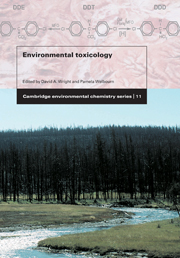Book contents
- Frontmatter
- Contents
- Foreword
- Preface
- Abbreviations
- Acknowledgements
- 1 The emergence of environmental toxicology as science
- 2 The science of environmental toxicology: Concepts and definitions
- 3 Routes and kinetics of toxicant uptake
- 4 Methodological approaches
- 5 Factors affecting toxicity
- 6 Metals and other inorganic chemicals
- 7 Organic compounds
- 8 Ionising radiation
- 9 Complex issues
- 10 Risk assessment
- 11 Recovery, rehabilitation, and reclamation
- 12 Regulatory toxicology
- 13 An overall perspective, or where to from here?
- Glossary
- Index
12 - Regulatory toxicology
Published online by Cambridge University Press: 05 June 2012
- Frontmatter
- Contents
- Foreword
- Preface
- Abbreviations
- Acknowledgements
- 1 The emergence of environmental toxicology as science
- 2 The science of environmental toxicology: Concepts and definitions
- 3 Routes and kinetics of toxicant uptake
- 4 Methodological approaches
- 5 Factors affecting toxicity
- 6 Metals and other inorganic chemicals
- 7 Organic compounds
- 8 Ionising radiation
- 9 Complex issues
- 10 Risk assessment
- 11 Recovery, rehabilitation, and reclamation
- 12 Regulatory toxicology
- 13 An overall perspective, or where to from here?
- Glossary
- Index
Summary
Introduction
Earlier chapters of this text referred to the identification of toxic substances, to various tests that identify potentially harmful concentrations of these, and to the need for regulation of toxic substances in the environment. As identified by Rand (1995), toxicity data (in his examples, aquatic toxicity data) have a variety of applications in protecting environmental quality. Examples include corporate industrial decisions on product development, manufacture, and commercialisation; registration of products to satisfy regulatory requirements; permitting for discharge of municipal and industrial wastes; environmental or ecological hazard-risk assessments; prosecution and defence of chemical-related activities in environmental legislation; and development of numerical [water and sediment] criteria for the protection of [aquatic] organisms.
This chapter deals with some of the ways in which regulatory bodies, typically governments at various levels or their agencies, attempt to protect the environment from the harmful effects of toxic substances. Environmental law has many facets and is a rapidly growing discipline. Although it is also very young in comparison with many other bodies of law, it is very extensive, and the present text cannot attempt to cover in any detail even those aspects that deal with toxic substances. The main purpose of this chapter is to present some of the principles involved in the regulation of potentially toxic substances, in the context of the protection of the environment as it affects human health and ecosystems. Occupational health is not dealt with except peripherally where the law in that area overlaps with the regulation of toxic substances in the more general environment.
- Type
- Chapter
- Information
- Environmental Toxicology , pp. 550 - 590Publisher: Cambridge University PressPrint publication year: 2002



